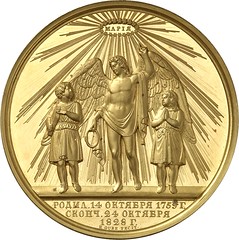
PREV ARTICLE
NEXT ARTICLE
FULL ISSUE
PREV FULL ISSUE
MEDAL OF TSARINA MARIA FEODOROVNA, MEDALIST


Ursula Kampmann writes: I have made for Künker a little press release on the most expensive lot, which was sold in the Berlin sale. It's about a German princess on the Russian throne who dedicated her time to design medal dies.
Interesting! Thanks for sharing this story of the Russian Tsarina medalist!
-Editor
She was a truly remarkable woman, that Sophia Dorothea Augusta Louise of Wuerttemberg, who – as second wife of Paul I - gave birth to two Russian tsars: Alexander I and Nicholas I. Now, a gold medal created on the occasion of her death has been sold at Künker for 180,000 euros! It is an impressive medal. It exhibits a marvelous portrait of Maria Feodorovna, née Sophia Dorothea Augusta Louise of Wuerttemberg in 1759. The obverse shows a bust of the empress created by P. Utkin. She wears a diadem decorated with oak leaves that represent the Tsarina’s support of the poor among her subjects. On the reverse an angel is depicted surrounded by two shocked children who can only pray sorrowfully. The angel points with his left hand to the eye of God with the name of Maria written within. In his right hand he holds a ring consisting of a snake biting its own tail, as a symbol for eternity which the tsarina has become a part of. A bidder was willing to pay 180,000 euros for this perfectly preserved rarity. He acquired not just any medal but a piece of German-Russian history because the wife of Paul I was a remarkable woman who improved her family’s love for Germany a lot. By request of Frederick II of Prussia and Catherine II of Russia – both of them were to become known in history as ‘The Great’ –, the 17 year-old came to Russia, her new home. Although historiography often labels Paul I as being difficult and incalculable, Maria Feodorovna got along quite well with her husband in the first years of their marriage. She bore him four sons and six daughters. Catherine kept the heir to the throne, Paul, away from all political tasks which provided Maria Feodorovna with much time to apply herself to her artistic leanings. She designed cameos, carved ivory and is even said to have produced medal dies. Some Russian medals surely derive from her creativity. It was only after Catherine had died that Maria Feodorovna took over the duties of an empress: she devoted herself to social work, visited and supported hospitals, soup kitchens and orphanages so that the two children on the medal may well represent the ones impoverished she had left behind when she died. Maria had to deal with the political changes that accompanied the French Revolution. The events in France led to a serious discord between her and her husband who threatened to send her to a convent. She was saved from that fate by the palace coup of 1801 that cost her husband his life. After his death, the tsar’s widow continued to be a decisive factor at court. She influenced her two sons Alexander and Nicholas in her – i.e. conservative – interests and pursued ambitious marriage politics: her daughters married an archduke of Austria, the Hereditary Prince of Mecklenburg-Schwerin, the Grand Duke of Saxe-Weimar-Eisenach, the King of Wuerttemberg as well as the King of the Netherlands. Her sons were being given wives that came from Baden, Saxe-Coburg-Saalfeld, Prussia and Wuerttemberg. Acting as the center of her family, whose members were dispersed throughout Germany and Europe, she managed to influence political decisions again and again. Maria Feodorovna died in Pawlowsk in 1828 at the age of 69 years. The medal that was issued on the occasion of her death realized 180,000 euros, hence 220,000 euros including buyer’s premium, at the Berlin auction sale of Künker’s on 6 February 2014! And that was only the peak result of an incredible auction day. 7.4 million euros was the turnover on a single day. Seven lots obtained prices in the six-figure region. You may find all results at the Künker website at www.kuenker.de 702 Hammered down at 180.000 euros, the new owner had to pay more than 220,000 euros for this extremely rare and magnificently preserved gold medal of Tsarina Maria Feodorovna in the end. This is a telling example of the large number of impressive results achieved in Berlin on 6 February 2014. The turnover of a single day read 7.4 million euros. EMPLOYMENT OPPORTUNITY!Live and Work in Southern CaliforniaStack’s Bowers Galleries offers an important employment opportunity for the right person. We are seeking an experienced numismatist in the American series—coins, tokens, medals, and paper money—to work with our “dream team” of catalogers, building on the tradition of the Ford, Eliasberg, Bass, Cardinal, Norweb, Battle Born and other great collections. If you can write in an authoritative and compelling manner with a high degree of accuracy, this may be just right for you! You will be working in Irvine, a modern community in dynamic Orange County, California—one of the finest areas to live. We offer generous benefits including medical and dental coverage, 401K plan, and more. Our offices are in our own modern, state-of-the art building with all amenities. If you would like to be considered for this position please contact Q. David Bowers by mail or by email with your resumé, samples of your past writing (on numismatics or other subjects), and salary requirements: Mail to the attention of Q. David Bowers, PO Box 1804, Wolfeboro, NH 03894. Email to: Ckarstedt@stacksbowers.com Wayne Homren, Editor The Numismatic Bibliomania Society is a non-profit organization promoting numismatic literature. See our web site at coinbooks.org. To submit items for publication in The E-Sylum, write to the Editor at this address: whomren@gmail.com To subscribe go to: https://my.binhost.com/lists/listinfo/esylum All Rights Reserved. NBS Home Page Contact the NBS webmaster 
|